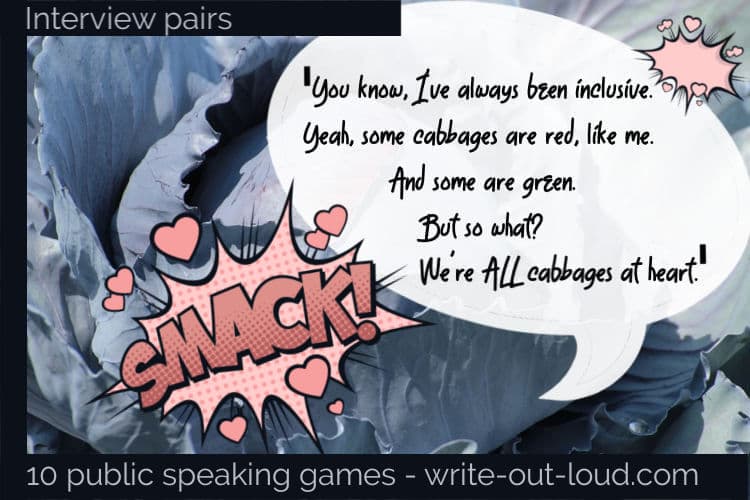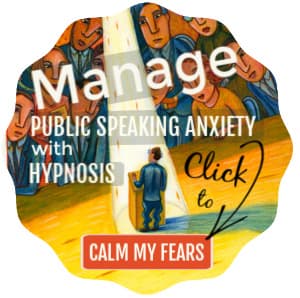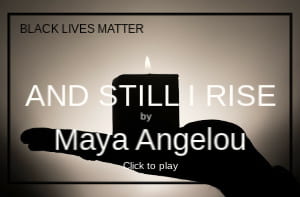- HOME ›
- Activities and games ›
- 10 activities for public speaking
10 superb activities for public speaking
Improv games to develop public speaking fluency, spontaneity and confidence while having fun!
By: Susan Dugdale
These activities for public speaking deliver imagination stretchers on steroids. If you've never interviewed a red cabbage or wondered what it was like to passionately campaign to save the lesser-spotted-three footed-teddy-bear from extinction, now's your chance!
The 10 I've listed below I used in my own teaching. They were picked up readily and enjoyed by students from middle school onwards. They've been equally successful with adults too.
Try them. An outbreak of joy is always welcome! You'll find yourself, and your students, laughing aloud! Played well and safely, these improv games build public speaking confidence and competence through fun. Lots of it! ☺
Ready, steady, go!
You can jump straight to an activity by clicking on its name:
Public speaking game guidelines
Please read the start-up guidelines if you've not used activities for public speaking like this before with your class or public speaking group. They'll help ensure everyone has the best experience possible, you included.
What do you need to start with?
- Some willing people: You can play these improv games in groups as small as 3-5. The optimum number is between 8 - 15 people. Any more than 20 and some activities become too cumbersome to manage.
- Some ground rules: Why rules? You are asking people to take risks. You don't want them annihilated by mockery or a flip derisive comment their first time out.
My ground rules are simple:
- No personal put downs of any sort (gesture or comment).
- Work to the best of your ability.
- Recognize and respect the effort being made by other players. - Some space: an ordinary living room or classroom is fine. You don't need a stage.
- Some courage: If you've not played improv games before the initial challenge for people to "get-over-themselves" and "get-on-with-it" is quite big. Once they've made the leap and safely landed on the other side, they'll wonder what all the fuss was about. Players will develop as speakers as well as having fun. The benefits far outstrip the risk!
How do you begin?
Start with explaining the games: why you're playing them and what they are.
Put the ground rules in place. If you're working with children sort out the consequences of breaking them ahead of the event. Is it time out? An apology to the person whose feeling were hurt?
Try the easier activities first to develop trust and confidence.
Feed-back sessions
I find these an invaluable teaching tool. They provide opportunity for myself and students to comment on the positive aspects of an activity as well as its challenges.
If you make them quick and focused between activities, you'll find people readily taking up and applying their insights in the next exercise.
1. One Minute Speeches

I've included three versions of One Minute Speeches on this page. The first is the basic or foundation one and then there are two extensions.
(All three versions, including all the resources needed to play them, are available in pdf format. Find out more >>>)
Instructions for the foundation version of One Minute Speeches
To play you need:
- a stop watch
- topics written out on small pieces of paper.
Examples: matchboxes, cars, princesses, travel, school, lessons, poetry, growing vegetables, children, books, pop stars, heroes, computers, writing... (Anything at all that you can reasonably expect the group you're preparing the exercise for to know about. Try not to be too prescriptive about how the subject is to be treated. Leaving the interpretation open gives the speaker more freedom.) - a group of 5 or more people. One person is the timekeeper and subject giver, the remainder are speakers.
Method:
Put all the topic papers in an open container face down.
The time keeper names a player to begin. The player chooses a piece of paper from the container. Once they have read the topic they give the topic paper to the time keeper who says: 'You have one minute on XXXX (name of subject on paper) starting from now.' The timer keeper then begins timing.
The goal for the speaker is to fill the minute.
If they do, award 10 points.
If they reach 50 seconds award 8 points.
If they get through 30 seconds award 5 points.
There are no points for stalling out before 30 seconds is up. A speaker is 'stalled out' if the time keeper can count slowly to three before the speaker starts speaking again. Once the time keeper gets to three, the speaker must sit down, and a new speaker is chosen.
Go through at least 3 rounds. Keep the tally of scores public. The winner is the person with the most points at the end of all rounds.
2. Advanced One Minute Speeches
The set-up is exactly the same as the foundation version of One Minute Speeches but further requirements are added.
The speeches must be delivered without undue: hesitation, deviation or repetition.
Be clear before you begin what the definitions of each of those are.
For example:
- Hesitation is stopping for more than a count of 2 seconds.
- Deviation is skewing the subject off topic completely. If the topic is animals and speaker is talking about birds, they are off topic.
- Repetition is either a repeat of material or words, other than the topic starter. (Take care not to set the bar too high. Go for verbs or adjectives first and then add more degrees of complication as your players gain confidence.)
For each infringement the time keeper, who keeps tally, will deduct a point from the final score.
3. Take Over Topic
This is another advanced variation on One Minute Speeches played with groups of 10 or more.
The set up is the same as the foundation version. You need a stop watch and prepared topics on bits of paper.
(You can ask the players to provide their own topics before you start. Have them write them down and put them into the container for picking out later.)
Method:
- Divide your group into two teams and give them a speaking order ie, speaker 1, speaker 2 and so on.
- Nominate a team to start
- Speaker 1 takes a topic. The stop watch is started and they begin.
The opposing team listens hard for opportunities to take-over the speech.
They are when the speaker deviates, hesitates or repeats himself. To take-over, they must call the challenge.
Example:
The speaker's topic is tennis but he is talking about soccer. The called challenge is deviation. The time keeper stops the watch.
The challenger explains the call.
The timekeeper judges whether or not it is fair.
If it is, the challenger takes over, the stop watch is set again for the remaining time and now the starting speaker's team may challenge.
If the challenge is unsuccessful, the original speaker continues.
The goal for the speaker is to survive the minute. If they do so, they get ten points. If they don't, whichever team is speaking last gets 5 points.
A full game is when you have gone through all the speakers from either side. It's fun, often raucous and quite absurd. Enjoy it!
Note: This game adapts well to specific subject areas. Set up a theme and make all your topics sub-themes.
Example:
Transport: cars, buses, trains, planes, bicycles, public transport, cars in the future, petrol costs, environmental concerns, car fashions...
Get all 3 versions of One Minute Speeches now!
The foundation (1), advanced (2) and take over topic version (3) of One Minute Speeches are available in a downloadable pdf format.
For $5.95 you get full instructions for each game variation PLUS 4 themed printable topic collections (368 topics).
4. Nonsense Word Definitions
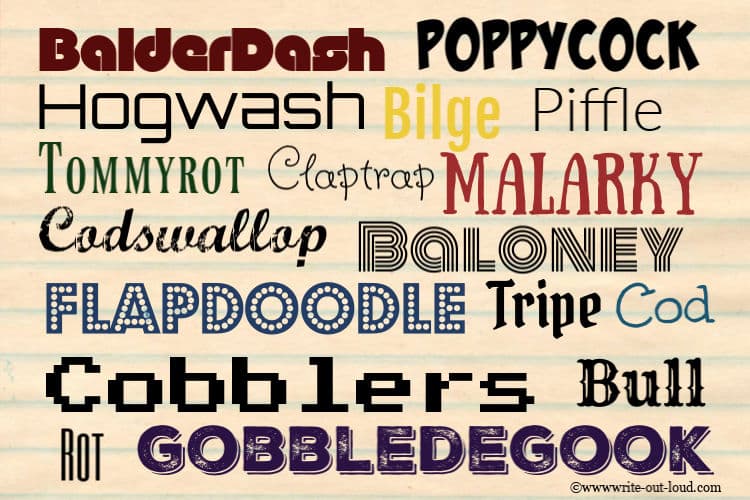
The key to playing this improv game well is assuming confident authority while spouting complete baloney, balderdash, rubbish, codswallop, piffle, tommyrot...
And yes, it's a lot of fun!
Each player takes a turn at receiving a nonsense word from the neighbor on their right. This word they must provide a plausible definition for.
To encourage inventiveness and creativity ask for the history of the word and its country of origin, whether it is a noun, verb, adjective etc, what it means and an example of it in use.
When they have completed their definition they then give another nonsense word to the player on their left.
Examples of nonsense words
zoppet, moxryn, tenplinth, oxypottle, minostun, appitzeen, klintsplot, baddle, closky, shint, wud, miggit...
Say them aloud. They sound almost like the real thing!
Example definition
The word I've received is "baddle" and here's my definition:
This is a variation of word "battle" which is another name for a fight, conflict, clash or struggle. An example of current usage is: He was injured on the baddle field and stretchered out.
Baddle is also a verb. For example: We baddled it out for first place in the basketball competition.
The variation, substituting the double letters of t for d, was adopted because people over many many years consistently failed to pronounce the two ts clearly. The d form of the word became acceptable.
5. Expert Interviews

Expert interviews is a paired activity. One person is the expert and the other the interviewer.
I've played it with many pairs working simultaneously as well as one pair at a time with the remainder of the group as audience. Either way it's good.
The benefits of everybody working at the same time is that it can break down excessive shyness. While the benefits of playing a pair at a time is everybody witnessing the process and learning from it.
How to play
Prepare ahead a list of 'expert' topics. Have fun with them without making them too rarefied with the result that no-one gets them.
Examples: a cabbage expert, a save-the-sand-fly expert, a maker of noises for the SFX department, the hamburger tasting specialist, an embarrassment expert, a birthday party specialist,...
Pair the players off. Have them decide which is expert and which is interviewer. The interviewer then collects the expert's topic from you. Their opening question or introduction lets the expert know his area.
Example opening:
'We're extremely fortunate today to have with us in the studio, Isaac Flugelhorn. Isaac is a well known, respected and published expert on the benefits of teaching children to read underwater. Isaac, I'd like to begin to by asking when you first realized your vocation?'
The game ends when the interviewer brings it to a close.
The goal for the expert is to 'live' into their expertise realistically and wholeheartedly regardless of how ridiculous the topic is or how little knowledge they have on the subject.
The goal for the interviewer is to draw out the expert by asking open ended questions. You may need to demonstrate these before you begin to avoid the frustration of simple "yes-no" or one word answers.
Swap the roles over so everybody has a turn at both.
Expert interview variation

My life as a XXXX (insert an object: door hinge, hammer, potato, egg, park bench, side-show clown...)
This variation can be played as a monologue or as a pair with one person being the interviewer. Again the goal is to fully accept and breathe life into whatever object you've selected or have been given.
Eg. How does it feel to be a side-show clown? What are the highlights? Please run through your training program that helps you prepare for the strain of having to keep your mouth open all day, and all night, long.
6. Advertising

This exercise is wonderful for developing small group confidence, creativity and trust.
How to play
Firstly you'll need a series of ideas to "sell".
Idea Suggestions:
National I Love You Day, Free Punctuation Packs (available with an extra 10 exclamation marks or 15 sets of speech marks), Eternal Sunshine, DIY Snow Kits for Sunny Places, Instant Fame, Society for the Abolition of Mondays ...
Split your group into small groups of 2-5 people and assign the topic for each.
Tell them they have approx. 20 minutes to put together an ad.
It must actively include all members of the group.
Encourage them to use song, dance, story telling, and sound effects.
The ads are performed one at a time.
Be sure to include a feed back session at the end where you encourage and compliment.
Variation: This can be done solo. Give topics and allow some planning time before performance.
7. My Favorite Things

This improv game is great for developing on-your-toes, creative, flexible thinking.
Gather up a series of props: a long scarf, a wooden box, a length of rope, a bowl, a ruler, a plastic funnel...(anything robust enough to be handled.) Place them in a covered box.
Divide your group into sets of 3-5 people.
Stand the first set up in front of the others.
Give the first person something out of the box. Whatever they get is their favorite thing. They must tell and demonstrate how their item is used and explain why they like it so much.
Encourage lateral thinking
If you've given the group a scarf to work with perhaps it could have saved lives when it was used as a rope to pull people back from the edge of a crevasse. It reminds the person holding it how valuable life is.
Or perhaps it once belonged to famous person whom they admire and was given to them as a gift.
Or maybe it is not a scarf at all but a long length of invisible encoded information that will save the world. It assumes the look of a scarf as a protection.
Whatever the object given to the first member of the group will be passed to the remaining members. They each have a turn explaining their favorite thing and each explanation must vary from the preceding ones.
Once they've finished, stand the next group up. Choose a different prop and begin again.
Tips to help
Encourage fast thinking and trust. It's better to go with the first idea rather than freeze and wait for another one to arrive.
If someone does freeze, don't let them stand in awkward silence. Pass to the next person and give them another opportunity when the rest of the group have finished. Please don't pressure them or make judgmental comments. They'll likely be doing that for themselves already!
It helps to start with some one fairly confident and free thinking. Their success will give the others courage to step out.
Keep the props covered to prevent pre-planning!
8. Story Circles
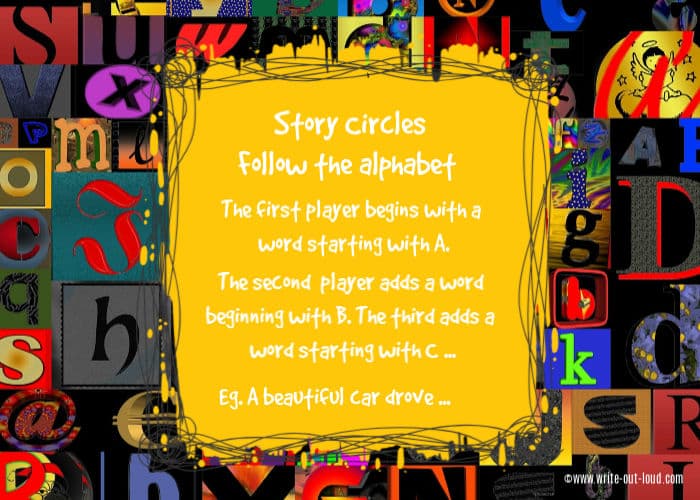
There are many variations on story circles. Start simply and build once confidence has been established.
Divide your group into sets of 5-8 members. The goal is keep the story moving along reasonably quickly.
Easy starters
A word at a time
Aim for a complete story: opening, middle and end in 4 rounds. Each person adds one word at a time.
Members have to help each other by making sure their word choices keep the story moving toward the desired goal.
Two words at a time
Each player add two words before handing the story on
Follow the alphabet:
The first word begins with A, the second word with B, etc.
Slightly harder variations
Add genre:
The story is now to be a fairy story, a ghost story, a love story, an action packed adventure, a western, a who done it...
Add in the style of:
It must be told in the style of a soap opera, a racing commentator, a news reader...
It must include the word 'XXXX' three times:
Example: wheelbarrow, rapacious, futile...
It must not include any words with the letter '?' in them
Insert the letter of your choice. (Don't make this too hard! E or A are really difficult to get around.)
9. Read in the Style of...

This is a fun solo exercise that I used to do with a telephone book. It's perfect for learning about vocal variety - something every public speaker needs.
(There, in two words I've given my age away! Do telephone books exist any more? If they don't where you are, get yourself a dictionary or something similar instead. Ideally you want text that is easily read, and not a story. Lists are good. Even a recipe book would work.)
Along with the text you'll need a list of commonly known styles for people to imitate.
Suggestions for styles: preacher, rap star, disc jockey, news reader, sports commentator...
Or you could go for emotional states: bored, happy, sad, enthusiastic, wary, angry, shy, snide, loving...
Stand each person up in turn, flip open the text and whatever they find there they are to read in the style nominated by you.
Have them read for approximately 30 seconds before handing the text to the next person and giving them a new style.
The key is to have people strive for exaggeration - the more the better! This is not reality. You want them to experience big, bold changes. These will register and give them something to remember and refer back to.
10. Pass the Tennis Ball
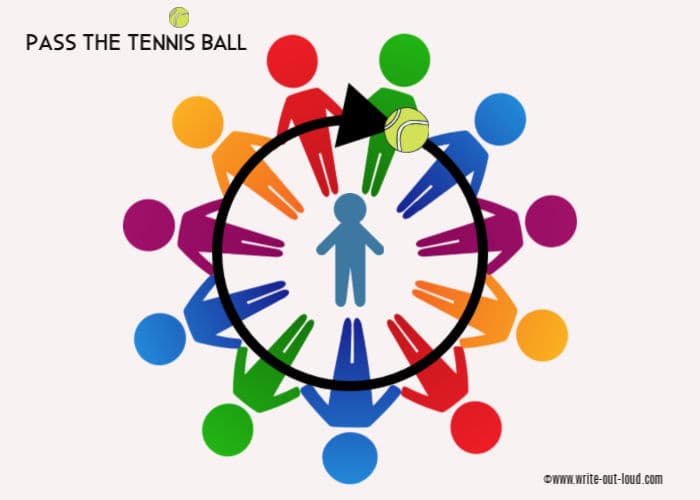
This improv game encourages split second thinking! It sounds easy but actually requires real concentration to play it well.
Sit your group in a circle. Have one person in the middle with their eyes closed.
Pass a tennis ball clockwise from player to player.
When the middle person calls 'Stop', and a letter ( A, B, C,...) the person holding the tennis ball has to name 6 words starting with that letter.
Meanwhile the ball keeps being passed round the circle.
The goal for the person naming the words is to have all 6 done before the ball comes back to them.
If they haven't, they change places with the middle player. If they have, the middle person closes their eyes once more, the ball starts being passed and when they're ready they call 'Stop' and another letter name.
Don't allow place names, first names or some of the tougher letters. (X for example!)
As your players get better increase the number of words required.
The reason for having the middle player's eyes closed as the ball is going round is so they won't know who has got it when they call.
Summary comments
All of these ten activities for public speaking effectively encourage the development of confidence, creativity, imagination, and speech skills.
You'll find once your students or group are comfortable with them, they'll begin asking to play them again and again. Vary them. Increase the level of difficulty and make sure if you're using groups or pairs you re-mix them for each activity.
Monitor the feedback carefully. Praise efforts made towards excellence as well as excellence itself. Be sincere and lavish with it. You can never give too much encouragement!
If someone "freezes" or makes a "can't do, this is stupid" comment understand they are probably feeling vulnerable and perhaps threatened. Leave them out with an option of returning but do not buy into an argument over the rightness of their challenge or the validity of the game. Carry on having fun. Make sure you praise any effort they subsequently make to enter into the spirit of the games.
If a game falters through lack of understanding by most of its players, or fear, stop it. There is no sense in pushing something meant to be fun when it's not. If you can, simplify and start again.
If you liked these games ...
You'll love my e-book!

(I've made an ebook of public speaking games - the ten on this page plus a whole lot more. You get everything you need to play them - instructions, printable resources ... Find out more >>>)
